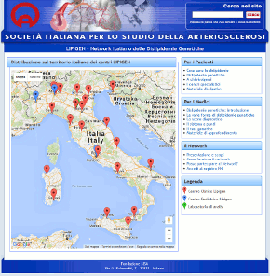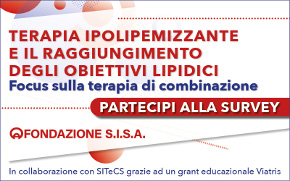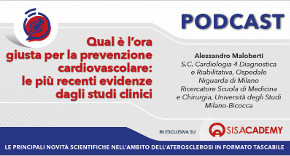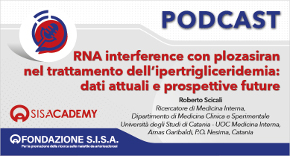 Rivista in lingua italiana
Rivista in lingua italiana
riservata ai Soci SISA
Ultimo numero:
Anno 16 • N.1/2025
SISANews
Effetto delle statine sulle placche aterosclerotiche coronariche
Sebbene le statine riducano il rischio di eventi avversi cardiovascolari maggiori, i loro effetti a lungo termine sull'aterosclerosi coronarica rimangono poco chiari. Questo studio ha cercato di descrivere l'impatto delle statine sulle placche aterosclerotiche coronariche, in termini quantitativi e qualitativi. In una valutazione prospettica in un registro di oltre 1200 pazienti senza storia di malattia coronarica sottoposti più volte ad angiografia tomografica computerizzata coronarica, a intervalli di almeno 2 anni, le statine sono risultate associate a una progressione più lenta del volume complessivo di aterosclerosi coronarica, con aumento della calcificazione della placca e riduzione delle placche ad alto rischio. Sebbene non influenzassero la progressione di stenosi coronariche gravi, riducevano efficacemente il rischio di rimodellamento positivo.
![]()
Effects of Statins on Coronary Atherosclerotic Plaques: The PARADIGM Study
Lee SE, Chang HJ, Sung JM, Park HB, Heo R, Rizvi A, Lin FY, Kumar A, Hadamitzky M, Kim YJ, Conte E, Andreini D, Pontone G, Budoff MJ, Gottlieb I, Lee BK, Chun EJ, Cademartiri F, Maffei E, Marques H, Leipsic JA, Shin S, Choi JH, Chinnaiyan K, Raff G, Virmani R, Samady H, Stone PH, Berman DS, Narula J, Shaw LJ, Bax JJ, Min JK.
JACC Cardiovasc Imaging. 2018;11:1475-1484
OBJECTIVES: This study sought to describe the impact of statins on individual coronary atherosclerotic plaques.
BACKGROUND: Although statins reduce the risk of major adverse cardiovascular events, their long-term effects on coronary atherosclerosis remain unclear.
METHODS: We performed a prospective, multinational study consisting of a registry of consecutive patients without history of coronary artery disease who underwent serial coronary computed tomography angiography at an interscan interval of ≥2 years. Atherosclerotic plaques were quantitatively analyzed for percent diameter stenosis (%DS), percent atheroma volume (PAV), plaque composition, and presence of high-risk plaque (HRP), defined by the presence of ≥2 features of low-attenuation plaque, positive arterial remodeling, or spotty calcifications.
RESULTS: Among 1,255 patients (60 ± 9 years of age; 57% men), 1,079 coronary artery lesions were evaluated in statin-naive patients (n = 474), and 2,496 coronary artery lesions were evaluated in statin-taking patients (n = 781). Compared with lesions in statin-naive patients, those in statin-taking patients displayed a slower rate of overall PAV progression (1.76 ± 2.40% per year vs. 2.04 ± 2.37% per year, respectively; p = 0.002) but more rapid progression of calcified PAV (1.27 ± 1.54% per year vs. 0.98 ± 1.27% per year, respectively; p < 0.001). Progression of noncalcified PAV and annual incidence of new HRP features were lower in lesions in statin-taking patients (0.49 ± 2.39% per year vs. 1.06 ± 2.42% per year and 0.9% per year vs. 1.6% per year, respectively; all p < 0.001). The rates of progression to >50% DS were not different (1.0% vs. 1.4%, respectively; p > 0.05). Statins were associated with a 21% reduction in annualized total PAV progression above the median and 35% reduction in HRP development.
CONCLUSIONS: Statins were associated with slower progression of overall coronary atherosclerosis volume, with increased plaque calcification and reduction of high-risk plaque features. Statins did not affect the progression of percentage of stenosis severity of coronary artery lesions but induced phenotypic plaque transformation. (Progression of AtheRosclerotic PlAque DetermIned by Computed TomoGraphic Angiography Imaging [PARADIGM]; NCT02803411).
JACC Cardiovasc Imaging. 2018;11:1475-1484

Area Soci
Eventi
39° Congresso Nazionale
 39° Congresso Nazionale
39° Congresso NazionaleRoma, 23-25 novembre 2025
Save the date




 Spring Meeting Gruppi Giovani SID, SIGG, SIIA, SIMI, SIPREC, SISA
Spring Meeting Gruppi Giovani SID, SIGG, SIIA, SIMI, SIPREC, SISARimini, 6-8 aprile 2025
[continua a leggere]
 SISA LIPID ACADEMY - Corso avanzato di lipidologia clinica
SISA LIPID ACADEMY - Corso avanzato di lipidologia clinicaModena, 4-5 Luglio 2024
[continua a leggere]Giornale Italiano Arteriosclerosi
HoFH today
 Rivista Italiana della
Rivista Italiana della
Ipercolesterolemia
Familiare Omozigote
Anno 6 • N.1/2024
Rivista NMCD
Diateca
[continua a leggere]
[continua a leggere]
Newsletter
il vostro indirizzo di posta elettronica
Progetto LIPIGEN

Nuovo sito dedicato al Progetto LIPIGEN
Progetto LIPIGEN - Vecchio portale
E' necessario essere loggati come utente
Lipigen per poter accedere alla pagina
PROject Statin Intolerance SISA
PROSISA – PROject Statin Intolerance SISA
E' necessario essere loggati come utente
PROSISA per poter accedere alla pagina
GILA - Lipoprotein Aferesi
Gruppo Interdisciplinare Lipoprotein Aferesi
(Accesso Gruppo GILA-Lipoprotein Aferesi)
E' necessario essere loggati come utente del Gruppo GILA per poter accedere
Gruppo Interdisciplinare Lipoprotein Aferesi
(Documentazione ad accesso libero)
Pagina informativa per medici e pazienti










